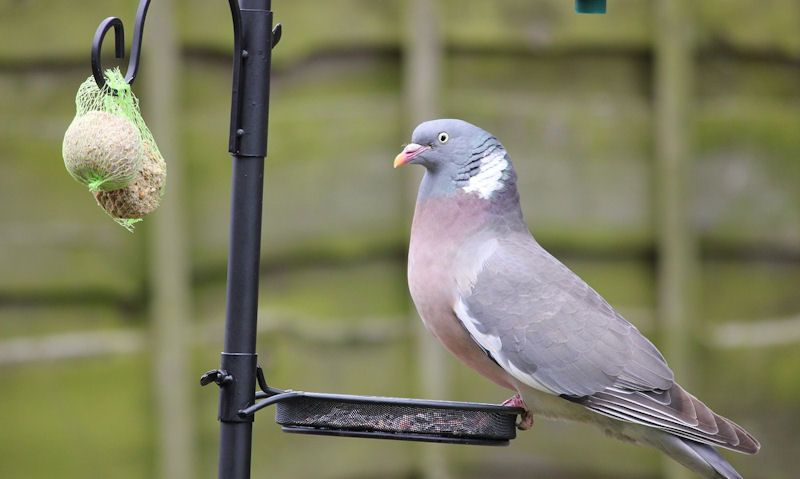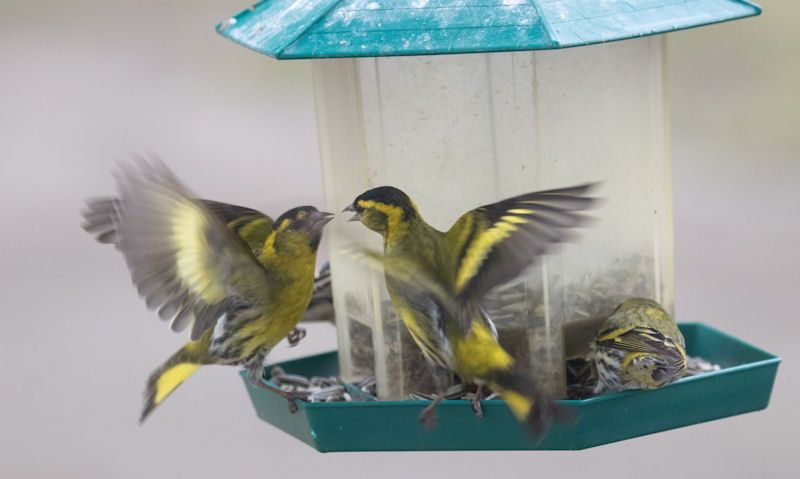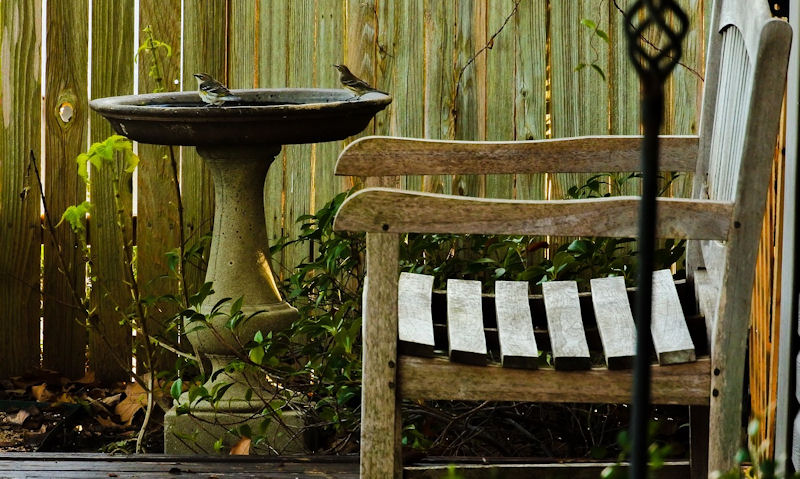Keep pigeons away from bird feeder
Simple wooden bird feeders to a complex bird feeding station on a stand are both ideal for attracting birds to you garden to feed, but it comes with a problem.
To keep pigeons away from bird feeders is a matter of patience, there's no shortcuts or guarantee, its simply a matter of gradually setting up tried and tested deterrents, until you discover the best fit, or with a combination. We would recommend you start with bird spikes sat on top of the feeder which is certain to stop pigeons resting.
With all the available bird feeders on the market, and that includes homemade feeders, its difficult to outline a plan for you as it depends largely on your own setup.
But what we will focus on are wooden bird feeders on a stand, to commercially available feeders in long, thin tubes hanging off a pole.
What we can guarantee is you'll get more success with larger, wooden feeders.
And there's a simple answer to this...
Bird feeders made from wood allow for modification, such as fixing deterring items on with nails or screws.
And well wooden feeders tend to have a larger slope where pigeons rest on before they make there plan of action to feed, the use of bird spikes can prevent them landing on the roof of the feeder.
Well made from plastic or metal, hanging bird feeders on stands have a whole set of new issues.
Long, thin made from plastic or metal bird feeders that hang off poles are mostly in reach of pigeons standing on a nearby platform or another feeding tray on the pole.
So the idea of keeping pigeons off these types of feeders needs a little imagination.
Before you do anything else, it would be best to position the hanging feeders, trays and fat balls far apart on the feeding station, and should be out of reach of pigeons.
Then you could use a combination of spikes or basic obstacles attached to the pole and feeders to cover up all possible landing spots.
Let's take a look at all options in more detail:
Bird safe, long to small length spikes
Don't be discouraged by the suggestion of bird spikes, rest assured these plastic or made from stainless steel spikes give way and are complete safe for birds.
Meaning, if the bird was to land on them, the spikes will either fold over or simply bend.
The idea behind bird spikes is a deterrent, they see these fierce spikes and wouldn't dare land on them. Like most deterrents, they are there to deter only, but never are used - which is the case of nukes.
And on that occasion they do land, they will soon fly away knowing as the spikes course them all sorts of problems, among them, the spikes flipping up all over the place.
Mind you, bird spikes are made to be attached horizontally, like the top of the bird feeder roof, garden fence or window sill.
Customise spikes for hanging bird feeder on pole
There're a number of bird spikes that can be used, but if you wish to keep pigeons away from an hanging bird feeder on a pole, you'll have to cut them up.
By that we mean there are a number of smaller, cone shaped spikes that can be bought in packs.
And well they are made to fit on wide fences or windows sills, you'll need to get out the Stanley knife, or a sharp cutting tool to cut them down into smaller pieces.
Well they are cut down into smaller pieces, you can then stick them to the curve of the pole and bracket, it might not look pretty, but it'll work.
How to adhere spikes to wood, metal or plastic
Before purchasing, you'll need to read the instructions on the packaging carefully looking out for details on adhering the spikes to the object in question.
Whether your feeder is made from plastic, metal or wood, you will need to look out for information outlining what it can't be attached to.
It would require you to purchase glue separately, and its that glue that would outline what is can and can't adhere to.
And well most spikes are made from durable plastic with a number of stainless steel spikes available, you'll need to find a glue that sticks on metal or plastic.
Then depending on your bird feeder - metal, wood or plastic - the glue in turn would need to adhere to that material.
But not to worry, the bird spike manufacturer should make a few suggestions, or they might recommend their own product.
Stop them landing with obstacles
You don't really need to go out a buy products that may stop pigeons eating bird food off the feeder, you just need to out smart them.
In this method, it requires patience as you test with different, usually natural materials, scattered around the feeder.
In the case of a big wooden bird feeder, you may want to prop up the outdoor broom, rake or clothes line up against all entrances to feeding table.
Then in the case of a bird feeding station on a pole, the same applies.
Here though, we would recommend clipping on a number of washing pegs on the feeding tray rim especially, well larger ones would need to be purchased to clip on around the wider pole.
Keep out of reach
Simple method of course relies on the positioning of not just the one bird feeder if you have it, but the whole lot.
With one bird feeding table or hanging feeder on a pole, this method won't apply as the pigeon does not have another platform other than the feeder to stand on.
What we're talking about is pigeons landing on multiple feeders on a pole system.
Hanging off the pole are a number of curving brackets, and off these brackets its where you setup your peanut, seed and maybe a suet ball feeder in a short distance apart.
All a pigeon needs to do here is stand on one feeder to reach the other.
In the process things can get a little messy as they fling out food as they balance. And well they're to big to reach the food beneath them, they only have to reach over to eat on the feeder on the next bracket over.
So make it hard for them.
Position far apart
Obviously, to stop the pigeons eating out of the feeder you'll need to position the feeders far apart, the fewer the feeders the harder it is.
There's no distance in inches we could recommend as they tend to find there own way around your separation, so keep an eye on things throughout the week to see if you need to make major changes or small tweaks.
Often you'll find you need to reposition all feeders in multiple heights or the same level before you're satified with the results.
Reduce the number of feeders
We estimate that three or less bird feeders would be significant to reduce the pigeons landing area, and in turn reaching over to feed.
As bird feeders are available for all types of bird feed, short or plump, long and thin; its you task to mostly keep the pigeons away from the suet/fat ball feeder.
Taking extra care to keep this fat ball feeder at a distance is imperative because its the pigeons goal to get hold of the suet.
And well access to the seed feeders are only limited to small birds, the peanut feeder with its mush design may be tempting for pigeons, so keep this one at a distance.
Stack on top
Regardless of how many bird feeders you have, for whatever feed they require and the design they come in, try to stack them one above the other.
If this isn't possible, at least try to stack them close by on one side of the feeder only.
You see by directly stacking them one on top of the other, it makes it impossible for the pigeon to land on either one, as they are to close to each other.
Summarise
So to keep pigeons away from your bird feeder would mostly rely on the use of bird safe spikes. This method alone would keep them away from your bird feeder, well limiting there options to land.
When that method has been tried and tested - but failed - its only a matter of stopping them eating from your feeder.
To do that you can position the feeders in a way that is out of reach, you could also reduce the number of feeders to decrease the number of landing areas.


